1. 引言
作为热带海洋上的一种强烈的暖心型气旋性涡旋,热带气旋的发生发展具有明显的地域性,不同海域的热带气旋无论在强度还是路径上都有很大的差异。长期以来,国内研究的重点主要集中在西北太平洋和北大西洋等地区 [1] - [4] 。目前国内科研机构几乎没有对南印度洋热带气旋开展针对性分析和数值模拟及预报研究,国际范围内也只有少数国家关注该海域海况,对南印度洋热带气旋做了一部分研究和应用 [5] - [7] 。现阶段,国内对于南印度洋热带气旋系统的预报保障方法,很大程度上还是主要依赖于实况监测、时空外推等经验型初级方法,缺乏对于该地域热带气旋的数值模拟和预报技术研究。
印度洋上的热带气旋常被称作“气旋性风暴”。南印度洋平均每年生成14.8个热带气旋,占整个印度洋热带气旋总数的73%,相当于全球热带气旋总数的19%。其中,西南印度洋与东南印度洋各占印度洋热带气旋总数的50%。与西北太平洋热带气旋相比,南印度洋热带气旋路径更具有多样性,有西南转向东南行、西南行、东行、西行、南行、东南行、东南转向西南行以及停滞、打转等八大类。上述路径中,以西南转向东南路径最多,约占热带气旋总数的60%,这种路径多发生在副高西侧,热带气旋沿副高西缘移动并转向 [8] 。
本文采用大气模式WRF [9] [10] ,有针对性的选取了南印度洋1102号热带气旋个例“Anggrek”,采用控制试验和bogus两种方案,对热带气旋进行模拟,分析了个例模拟路径、强度、动力和热力特征。数值模拟试验研究的初步开展,为今后在实际业务中南印度洋热带气旋路径和强度的数值预报工作提供建设性参考。
2. “Anggrek”热带气旋概况及特点
根据国际热带气旋警报中心(TCWC) Perth及Jakarta中心发布的公告以及“南印度洋和澳大利亚联合热带气旋警报中心”分级标准,2010年10月28日(UTC,下同),印度尼西亚(INDONESIA)雅加达(JAKARTA)西侧大约650公里附近洋面上有一个热带低压生成。随后两天该热带低压向南偏东方向移动并持续加强,于10月31日00时加强为热带气旋,命名为“Anggrek”,中文名字为“兰花”,气旋中心位于雅加达西偏南方向大约1270公里的洋面上,即8.5˚S,95.6˚E,中心附近最大风力有8级,中心附近最低气压为995百帕。31日晚些时候,Anggrek进一步加强为强热带气旋(相当于西北太平洋强热带风暴)。11月2日,Anggrek移至科科斯群岛东部,并开始由东南路径转为西南路径,TCWC Perth中心称,11月2日晚些时候该系统衰减为热带气旋(相当于西北太平洋热带风暴)。随后Anggrek继续向西南方向移动,于11月4日衰减为热带低压,中心位于科科斯群岛西岛南偏东方向大约230公里的洋面上(97.0˚E,14.2˚S),中心附近最大风力有8级,最低气压为995百帕,低压中心以每小时10~15公里的速度向西南方向移动,强度继续减弱,并于11月5日完全消亡。
Anggrek为科科斯群岛附近海域带来了强降雨和狂风大浪天气,少数树木和电力线被吹倒,没有人员伤亡的报道。图1为南印度洋1102号热带气旋“Anggrek”从29日至5日消亡前的最佳路径及11月2日10时的卫星云图。
3. 资料及试验设计介绍
3.1. 资料介绍
本文采用NCEP/NCAR逐6小时1˚ × 1˚的全球再分析资料作为模式初始和边界条件;用美国JTWC发布的最佳路径资料作为参考观测值,对模拟试验结果进行验证;地形、地表资料采用WRF模式配备的地形数据。
3.2. 试验设计
图2为热带气旋“Anggrek”数值模拟试验区域范围及地形,具体试验配置如表1所示,大气模式每3小时输出一次模拟结果。
4. 数值模拟试验结果分析
4.1. 热带气旋的路径模拟效果
图3和表2分别为JTWC年鉴资料和两组“Anggrek”数值模拟试验的热带气旋移动路径对比图及各时次误差统计情况。Control控制试验基本上模拟出了热带气旋的东南转西南路径走向,移速略快于实况;前48 h模拟路径对比实况略偏南偏西,后24 h模拟路径略偏东偏北;数值积分24 h、48 h、72 h热带气旋模拟路径误差分别为21.9 km,10.9 km,34.0 km。在初始场中加入人造涡旋的Bogus模拟试验中,热

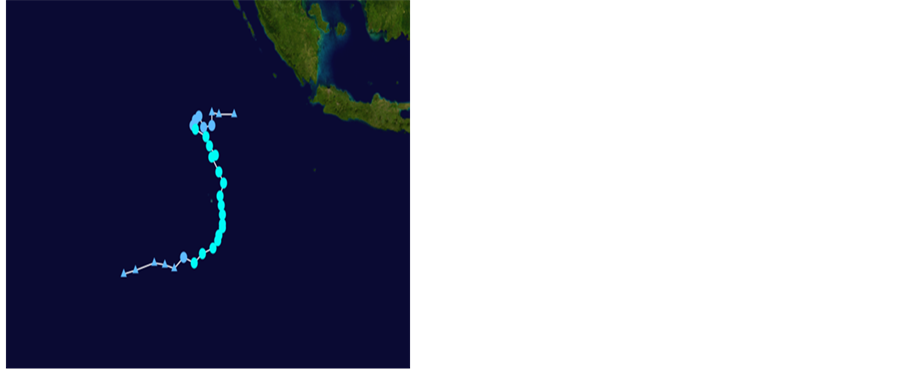 (a) (b)
(a) (b)
Figure 1. Best track (a) and MODIS satellite cloud chart at 10:00 on November 02 (b) of tropical cyclone Anggrek numbered 1102 in south Indian Ocean
图1. 南印度洋1102号热带气旋“Anggrek” JTWC最佳移动路径(a)及11月02日10时MODIS卫星云图(b)

Figure 2. Area and terrain of Anggrek’s numerical simulation test
图2. “Anggrek”数值模拟试验区域范围及地形

Table 1. Parameters setting of tropical cyclone Anggrek’s numerical simulation test
表1. 热带气旋“Anggrek”数值模拟试验参数设置
带气旋路径模拟效果较差:前24 h基本模拟出热带气旋的东南路径走向,略偏东偏南,移速明显快于实况,在随后的模拟中路径与实况差别较大;数值积分24 h、48 h、72 h热带气旋模拟路径误差分别为65.7 km,87.0 km,129.5 km。
4.2. 热带气旋的强度模拟效果
图4和表3显示了热带气旋“Anggrek”模拟试验和观测资料的海平面最低气压随时间变化及其误差统计情况。
数值积分前45 h中,两个试验均模拟出了热带气旋发展加强过程中海平面气压不断下降的趋势,其中,bogus方案模拟效果好于control试验,气压下降过程更加稳定,没有出现类似于control试验中spinup

Figure 3. Track of tropical cyclone Anggrek
图3. “Anggrek”热带气旋移动路径
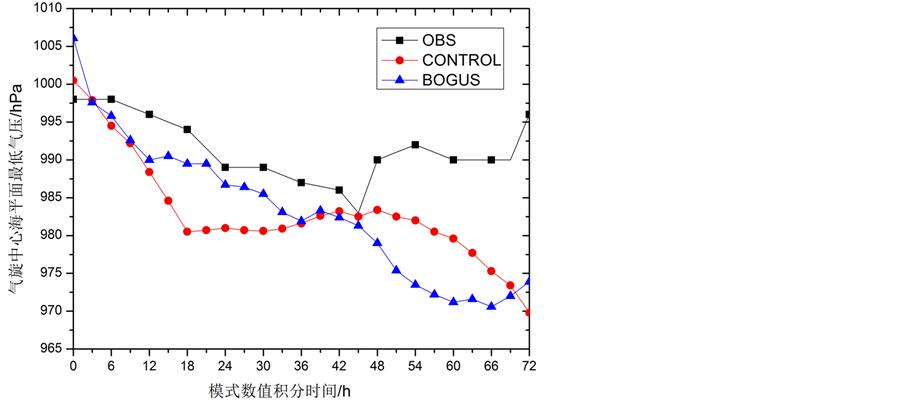
Figure 4. Changes of tropical cyclone Anggrek’s sea-level lowest pressure with time
图4. 热带气旋“Anggrek”海面最低气压随时间变化

Table 2. Track error statistics of tropical cyclone Anggrek
表2. 热带气旋“Anggrek”移动路径误差统计(单位:km)

Table 3. Error statistics of tropical cyclone Anggrek’s simulating sea-level lowest pressure
表3. 热带气旋“Anggrek”模拟海面最低气压误差统计(单位:hPa)
过程中气压急剧下降的情况;对于数值积分45~72 h热带气旋出现的减弱趋势,两试验模拟效果较差,bogus试验在模拟最后6 h呈现出气压上升的趋势,而control试验则完全没有模拟出该趋势。Control和bogus方案的24、48和72小时模拟气压与观测资料偏差分别为−8.0、−6.6、−26.2 hPa和−2.3、−11.0、−22.1 hPa。
除了海面最低气压,我们还常采用海表10 m最大风速来代表热带气旋的强度,如图5和表4。对于数值积分0~24 h热带气旋加强阶段,两个试验均模拟出海面风速不断增加的趋势,其中,bogus试验模拟的最大风速增加稳定,较为接近实况,而control试验中海面10 m最大风速增强过于急剧,说明采用再分析资料作为初始场不利于模拟风场的稳定发展;数值积分24~48 h热带气旋成熟稳定阶段中,两试验效果一般,bogus试验模拟效果好于control试验;数值积分48~72 h热带气旋衰减阶段中,两试验均未模拟出最大风速衰减的趋势,其中bogus试验误差更大些。Control和bogus方案海面10 m最大风速的24、48和72小时模拟气压与观测资料偏差分别为14.4、3.9、17.6 m/s和2.1、4.2、19.0 m/s。
4.3. 热带气旋的动力结构
下文以control试验模拟结果为例,对热带气旋“Anggrek”的动力热力特征进行初步分析。
图6分别显示了为热带气旋“Anggrek”850、500、300、200 hPa风场分布。850 hPa和500 hPa风场分布均呈现明显的气旋式辐合;在300 hPa风场分布中,气旋式运动也很明显,但是没有明显的辐合特征;而200 hPa风场分布中出现了明显的气旋式辐散现象。这说明,WRF模式很好的模拟了热带气旋成熟阶段底层流入、高层流出的流场分布。
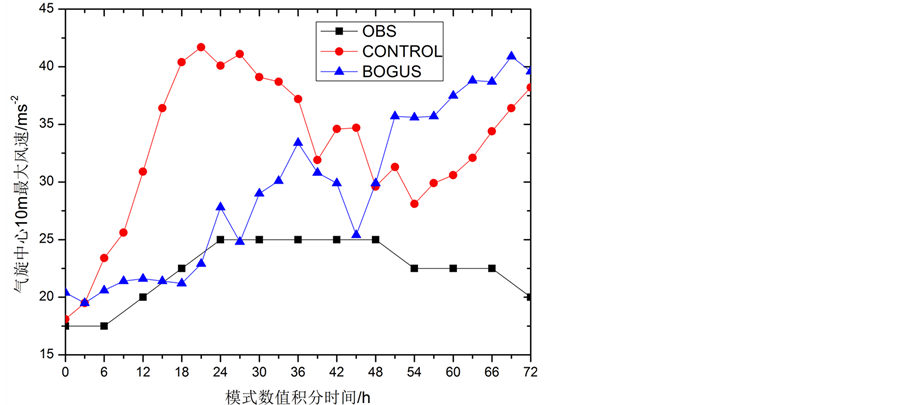
Figure 5. Changes of tropical cyclone Anggrek’s 10 m maximum wind with time
图5. 热带气旋“Anggrek”海面10 m最大风速随时间变化

Table 4. Error statistics of tropical cyclone Anggrek’s simulating 10 m maximum wind
表4. 热带气旋“Anggrek”模拟海面10 m最大风速误差统计(单位:m/s)
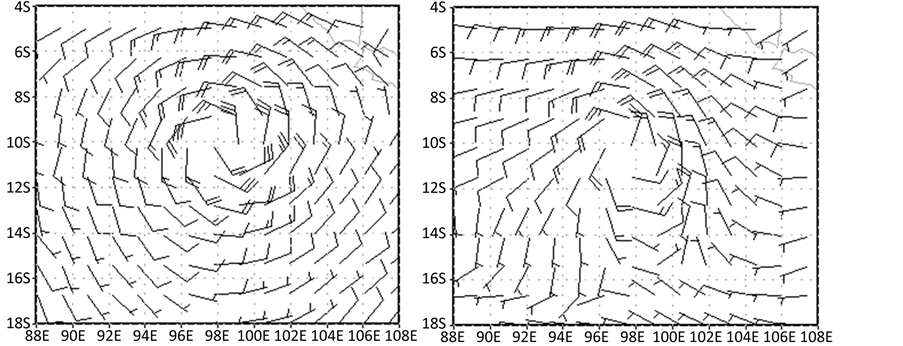 (a) (b)
(a) (b)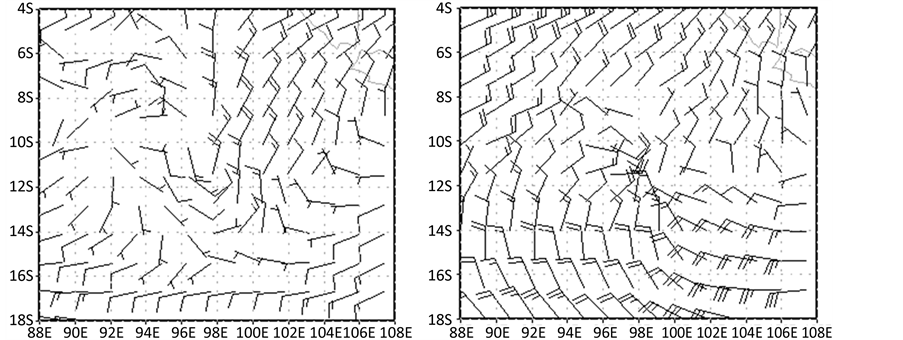 (c) (d)
(c) (d)
Figure 6. Tropical cyclone Anggrek’s wind distribution at the 36 h simulation (a) 850 hPa, (b) 500 hPa, (c) 300 hPa, (d) 200 hPa
图6. 积分36 h热带气旋“Anggrek”(a) 850 hPa、(b) 500 hPa、(c) 300 hPa、(d) 200 hPa风速分布
4.4. 热带气旋的热力结构
在温度场方面,热带气旋在中高层主要表现为暖心结构,暖心结构的形成一方面是由于热带气旋中心区的辐合上升气流中水汽凝结释放大量潜热,另一方面也是热带气旋中心下沉气流绝热增温作用的结果。
图7中显示了热带气旋“Anggrek”12 h、24 h、36 h、48 h时,过气旋中心的温度距平纬向垂直分布。对比各时次暖心结构可知,气旋发展阶段(12~24 h)高空温度距平区域逐渐增大,距平强度逐步增大;气旋成熟阶段(24~36 h)高空暖心结构范围扩张的最大,强度增强且温度距平高值区向上扩展到250~150 hPa,暖心高度达到最高;衰减起始阶段(48 h)高空温度距平极值区高度下降到400 hPa或以下,同时距平强度也逐步降低。
5. 结论
1) 本文利用WRF模式对热带气旋进行数值模拟效果较好,不仅模拟出热带气旋的路径、强度,对其动力热力结构的刻画也较为真实。
2) 两个方案对于热带气旋发生发展的趋势模拟较好,特别是对于发展加强趋势均作出了较好模拟,
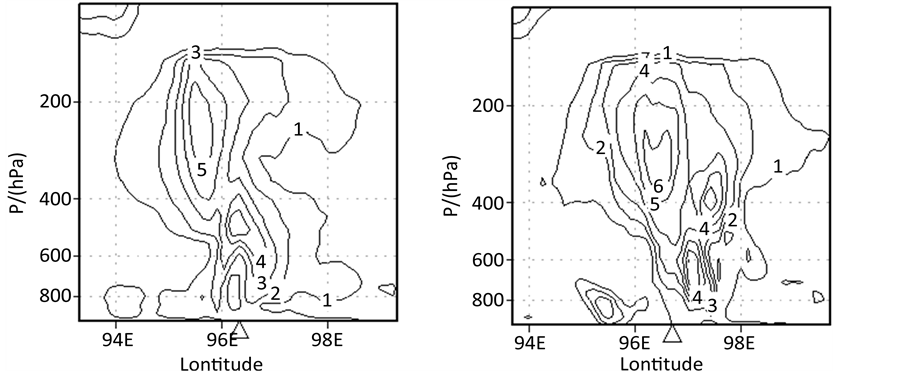 (a) (b)
(a) (b)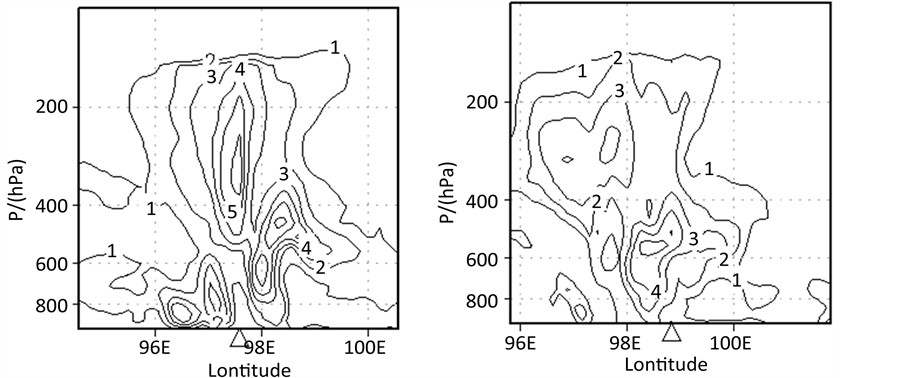 (c) (d)
(c) (d)
Figure 7. Temperature anomaly’s latitudinal profile through cyclone center of Tropical cyclone Anggrek at the simulation time of (a) 12 h, (b) 24 h, (c) 36 h, (d) 48 h (unit: K, Contour interval: 1 K)
图7. 积分(a) 12 h、(b) 24 h、(c) 36 h、(d) 48 h时热带气旋“Anggrek”过气旋中心的温度距平纬向剖面图(单位:K,等值线间隔:1 K)
对于衰减趋势模拟效果稍差,这可能与模拟积分时间过长有关。
3) 数值模拟对于初始场具有很强的敏感性。在初始场中加入bogus人造涡旋对初始场进行改善,在海平面最低气压和海平面10 m最大风速两方面均改善了热带气旋强度模拟,特别改善了spinup过程中容易出现的不稳定和强度速降现象。
4) WRF模式对于热带气旋的模拟强度普遍偏强,这与热带气旋期间很多物理过程的具体机理尚不明确有关。
基金项目
国家973研究项目(613202)。